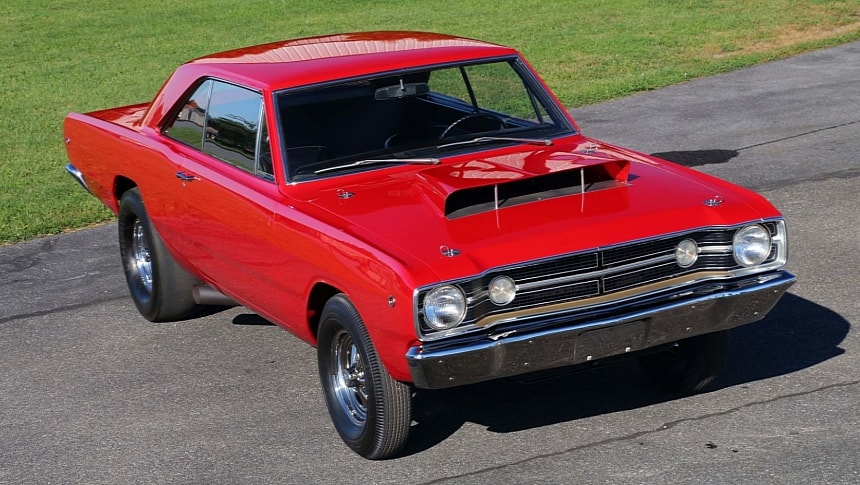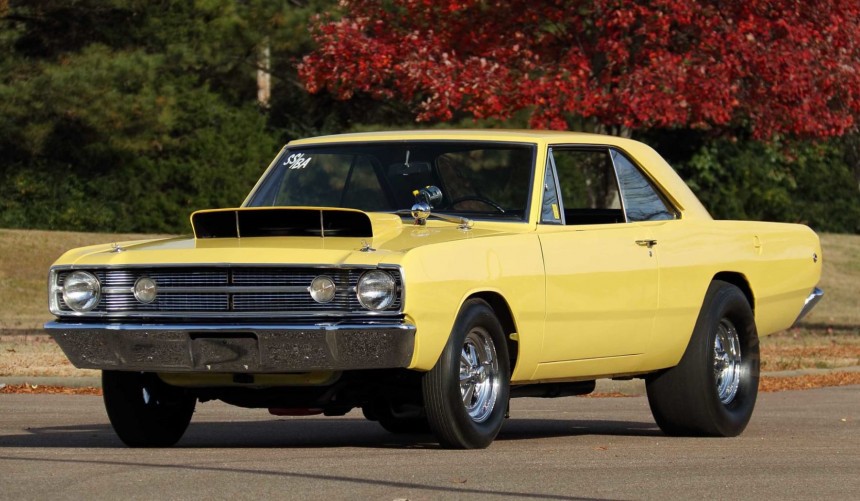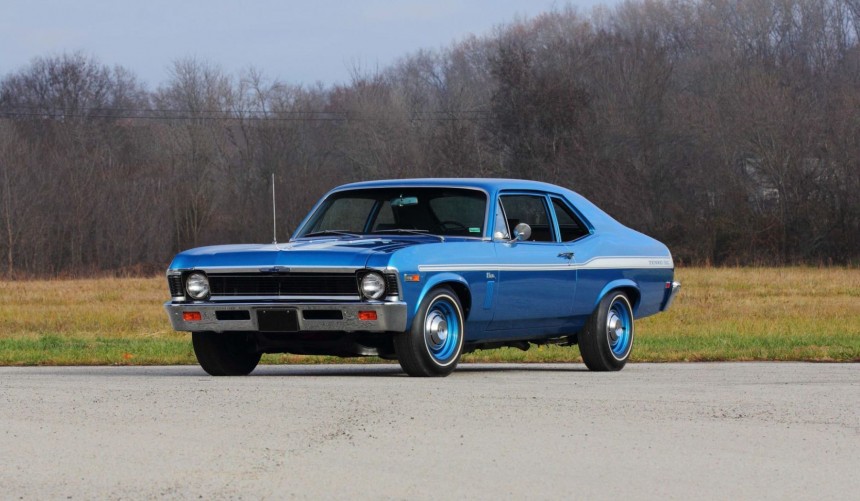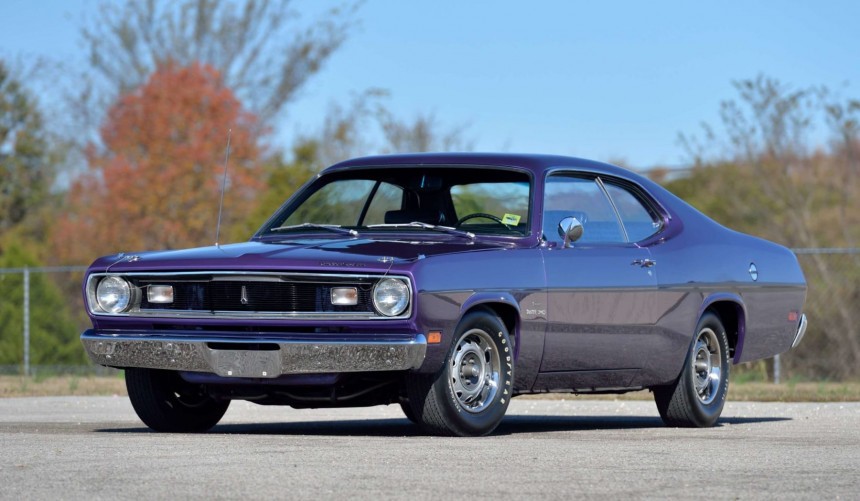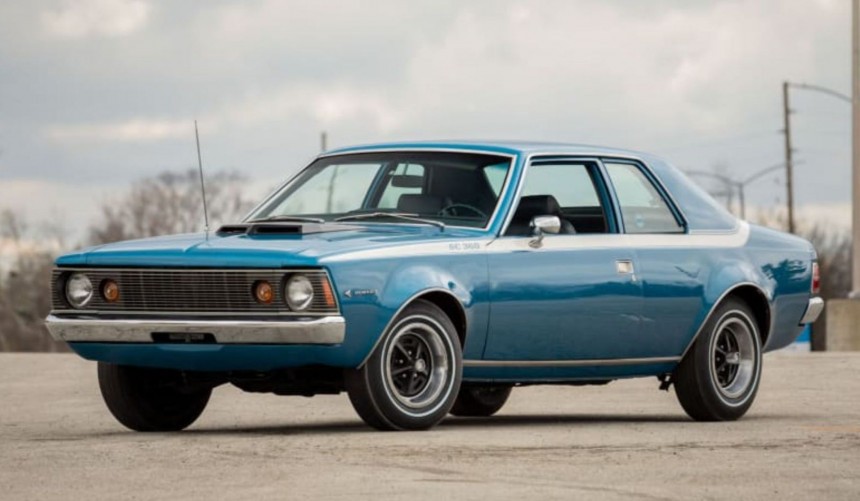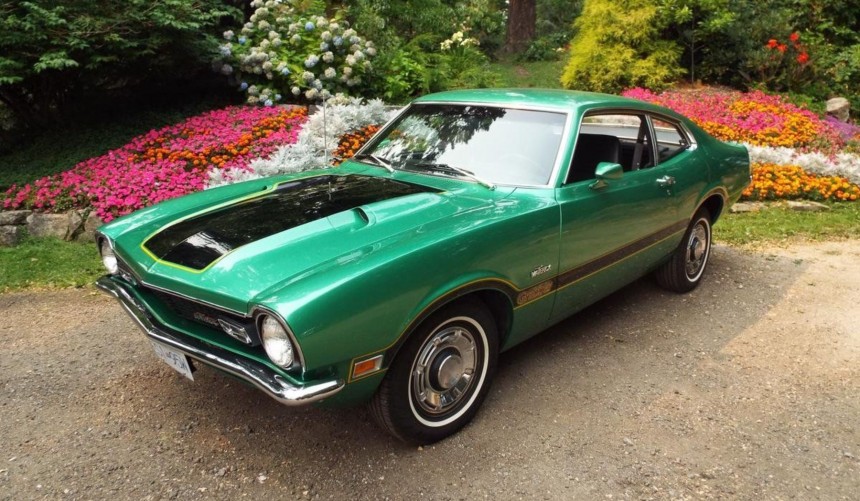Smaller and thus lighter, American compacts built during the 1960s and 1970s became lethal when equipped with some of the era's most potent high-performance V8s.
During the 1960s, powerful V8 engines, usually reserved for full-size models or sports cars like the Corvette, started appearing in the engine bays of smaller passenger cars.
Intermediates were among the first to receive the high-performance treatment, with the wildly popular 1964 Pontiac GTO being credited with kickstarting the muscle car craze.
But American carmakers didn't stop at intermediates. Soon, smaller pony cars and compacts became available with high-performance engines.
The latter segment was arguably the least popular among muscle car fanatics, but it delivered some legendary high-performance rides like the five that we'll cover in this article.
The fourth-generation Dart made its debut in 1967 as a much-improved version of Dodge's compact offering.
Available in various trims with several engines to choose from it was fairly popular, but even with the most potent V8 available, it was no high-performance compact.
That changed late in 1968 when Dodge introduced several performance-oriented versions of the Dart like the flashy Swinger and the improved GTS.
However, during that model year, the Chrysler division also introduced a special drag strip-oriented, limited-edition Dart that hid a humongous surprise under the hood.
Built in collaboration with Hurst Performance, which handled the engine transplant and modifications, the limited-edition homologation special was developed to meet the NHRA's Class B Super Stock specifications.
In order to become a drag strip conquerer, the Dart received a fiberglass scooped hood and fenders, lightweight acid-dipped steel doors with thin side windows, a stripped interior with two bucket seats, and last but not least, a 426 HEMI.
Though conservatively rated at 425 hp, the humongous V8 was no street HEMI but an improved, race-spec version that allowed the 3,000-pound (1,361 kg) compact to dart across the quarter mile in less than 11 seconds at speeds exceeding 130 mph (209 kph).
Though theoretically street-legal, the 80 HEMI Darts built in 1968 came with factory disclaimers that warned owners not to drive them on public roads.
During the mid-1960s, Don Yenko, the owner of a famous Chevy dealership, went from modifying and racing Corvettes to building some of the most epic muscle cars with Bowtie badges.
He started with the Corvair-based Stinger in 1966, then continued with the 1967 427 L72-swapped Yenko Camaro.
He continued offering the insane big-block Camaro during the 1968 model year and again in 1969.
However, 1969 also saw the addition of a new Yenko supercar based on the compact Nova.
Following the same recipe used on the pony car, Yenko ordered a series of Nova SS units and swapped their 375-hp 396 V8s with modified L72 big blocks.
Additionally, Yenko and his crew added an M21 four-speed manual and a 12-bolt Positraction rear differential, delivering arguably the most insane street-legal muscle car of the era.
With 450 hp on tap, the SYC 427 Nova could accelerate to 60 mph (97 kph) from a standstill in the 5.5 to 6-second range and run the quarter mile in less than 11 seconds (with racing slicks).
A one-year-only affair, the SYC 427 Nova was produced in 38 units, one of which was an automatic transmission-equipped prototype.
For the epic 1970 model year, Plymouth introduced a semi-fastback two-door coupe version of its compact Valiant.
An affordable sporty compact aimed at the younger demographic, the standard Duster was available with a series of engines ranging from a Slant-6 to a 318-ci (5.2-liter).
However, for the incurable speed addicts on a tight budget, Plymouth also offered a high-performance version dubbed Duster 340.
As the name implies, it was powered by a 340-ci (5.6-liter) equipped with hammer-forged steel conrods, high-compression cast aluminum pistons, and a four-barrel carburetor fitted on top of a high-rise, dual-plane intake that fed high-flow cylinder heads.
Paired with either a standard three-speed manual, an optional, four-speed, or a three-speed TorqueFlite (also optional), the 340 V8 was rated at 275 hp. However, since insurance ratings were on the rise, it turned out that the output was purposefully understated, and the actual potential of the performance engine stood closer to the 325 hp mark.
Regardless of the actual output figure, the Duster 340 could consistently run the quarter mile in the high 13-second range, which meant it was quicker than any 1970 Ford, the SS 396 Chevy Chevelle, or the 440 Pontiac GTO and Firebird.
With giant-slaying performance and an attractive price tag, the Duster 340 was extremely popular. At the end of the 1970 model year, Plymouth managed to sell 24,817 units of the high-performance compact.
During the golden age of muscle, the American Motors Corporation (AMC) was the only relatively small carmaker that challenged Detroit's Big Three in the performance arena.
It did so with intermediates like the 1969 S/C Rambler and the 1970 Rebel-based Machine, but by 1971, rising insurance premiums and upcoming emission restrictions meant that the muscle car era was coming to an end.
Though it continued to offer a performance-oriented package for the mid-size Matador, AMC shifted its focus to offering muscular versions of its Javelin pony car and compact Hornet.
For the latter, a cheap, entry-level compact launched in the fall of 1969, AMC offered an all-new performance-oriented sub-model called SC/360.
Based on the standard, two-door Hornet, the SC/360 distinguished itself from its standard sibling thanks to a functional Ram-Air-type hood (optional) and contrasting stripe package.
However, the most important upgrade was a 245-hp tall-deck, 360-ci (5.9-liter) that used to be the standard motor in the now-discontinued, two-seat AMX.
Apart from the standard engine, which made plenty of power for such a light platform, the SC/360 could also be equipped with options like the Go Package, which swapped the two-barrel carb with a larger four-barrel unit that upped output to 285 hp.
Other options that made the Hornet SC/360 even more impressive included a heavy-duty suspension, front disc brakes, a Twin-Grip differential, and a Hurst-shifted four-speed manual.
Fully equipped with all the options, the compact was able to run the quarter mile in the mid-to-high 14-second range, which made it one of the fastest performance cars in its price range.
With performance enthusiasts turning to hot compacts to avoid sky-high insurance rates, Ford also introduced a trim dubbed Grabber for its all-new Maverick in the second part of the 1970 model year. However, it was merely a cosmetic trim that offered no distinct performance upgrades.
By 1971, the Grabber was more refined, receiving a special dual scoop hood, a new rear spoiler, a deluxe steering wheel, and some much-needed performance upgrades.
Available only for the two-door hardtop Maverick, the Grabber, which featured a distinct decal package, was no longer powered by one of the three straight-six versions and could be had with a V8.
Though not Ford's most impressive engine, the 302-ci (4.9-liter) small block equipped with a two-barrel carb delivered a healthy 210 hp, making the 1971 Grabber more exciting than its predecessor.
Still, the compact could only achieve a mid-16-second quarter-mile run, which made the Hornet SC/360 seem like a legitimate muscle car.
However, the lightweight Maverick and its tuner-friendly small-block V8 proved a great package for many enthusiasts who transformed the compact into a veritable drag-racing monster.
One of those enthusiasts was the legendary "Dyno" Don Nicholson, who won the Pro Stock title in 1971 with his modified Grabber.
Intermediates were among the first to receive the high-performance treatment, with the wildly popular 1964 Pontiac GTO being credited with kickstarting the muscle car craze.
But American carmakers didn't stop at intermediates. Soon, smaller pony cars and compacts became available with high-performance engines.
The latter segment was arguably the least popular among muscle car fanatics, but it delivered some legendary high-performance rides like the five that we'll cover in this article.
1968 Dodge HEMI Dart
Available in various trims with several engines to choose from it was fairly popular, but even with the most potent V8 available, it was no high-performance compact.
That changed late in 1968 when Dodge introduced several performance-oriented versions of the Dart like the flashy Swinger and the improved GTS.
However, during that model year, the Chrysler division also introduced a special drag strip-oriented, limited-edition Dart that hid a humongous surprise under the hood.
Built in collaboration with Hurst Performance, which handled the engine transplant and modifications, the limited-edition homologation special was developed to meet the NHRA's Class B Super Stock specifications.
In order to become a drag strip conquerer, the Dart received a fiberglass scooped hood and fenders, lightweight acid-dipped steel doors with thin side windows, a stripped interior with two bucket seats, and last but not least, a 426 HEMI.
Though conservatively rated at 425 hp, the humongous V8 was no street HEMI but an improved, race-spec version that allowed the 3,000-pound (1,361 kg) compact to dart across the quarter mile in less than 11 seconds at speeds exceeding 130 mph (209 kph).
Though theoretically street-legal, the 80 HEMI Darts built in 1968 came with factory disclaimers that warned owners not to drive them on public roads.
1969 Chevy Yenko SYC 427 Nova
He started with the Corvair-based Stinger in 1966, then continued with the 1967 427 L72-swapped Yenko Camaro.
He continued offering the insane big-block Camaro during the 1968 model year and again in 1969.
However, 1969 also saw the addition of a new Yenko supercar based on the compact Nova.
Following the same recipe used on the pony car, Yenko ordered a series of Nova SS units and swapped their 375-hp 396 V8s with modified L72 big blocks.
Additionally, Yenko and his crew added an M21 four-speed manual and a 12-bolt Positraction rear differential, delivering arguably the most insane street-legal muscle car of the era.
With 450 hp on tap, the SYC 427 Nova could accelerate to 60 mph (97 kph) from a standstill in the 5.5 to 6-second range and run the quarter mile in less than 11 seconds (with racing slicks).
A one-year-only affair, the SYC 427 Nova was produced in 38 units, one of which was an automatic transmission-equipped prototype.
1970 Plymouth Duster 340
An affordable sporty compact aimed at the younger demographic, the standard Duster was available with a series of engines ranging from a Slant-6 to a 318-ci (5.2-liter).
However, for the incurable speed addicts on a tight budget, Plymouth also offered a high-performance version dubbed Duster 340.
As the name implies, it was powered by a 340-ci (5.6-liter) equipped with hammer-forged steel conrods, high-compression cast aluminum pistons, and a four-barrel carburetor fitted on top of a high-rise, dual-plane intake that fed high-flow cylinder heads.
Paired with either a standard three-speed manual, an optional, four-speed, or a three-speed TorqueFlite (also optional), the 340 V8 was rated at 275 hp. However, since insurance ratings were on the rise, it turned out that the output was purposefully understated, and the actual potential of the performance engine stood closer to the 325 hp mark.
Regardless of the actual output figure, the Duster 340 could consistently run the quarter mile in the high 13-second range, which meant it was quicker than any 1970 Ford, the SS 396 Chevy Chevelle, or the 440 Pontiac GTO and Firebird.
With giant-slaying performance and an attractive price tag, the Duster 340 was extremely popular. At the end of the 1970 model year, Plymouth managed to sell 24,817 units of the high-performance compact.
1971 AMC Hornet SC/360
It did so with intermediates like the 1969 S/C Rambler and the 1970 Rebel-based Machine, but by 1971, rising insurance premiums and upcoming emission restrictions meant that the muscle car era was coming to an end.
Though it continued to offer a performance-oriented package for the mid-size Matador, AMC shifted its focus to offering muscular versions of its Javelin pony car and compact Hornet.
For the latter, a cheap, entry-level compact launched in the fall of 1969, AMC offered an all-new performance-oriented sub-model called SC/360.
Based on the standard, two-door Hornet, the SC/360 distinguished itself from its standard sibling thanks to a functional Ram-Air-type hood (optional) and contrasting stripe package.
However, the most important upgrade was a 245-hp tall-deck, 360-ci (5.9-liter) that used to be the standard motor in the now-discontinued, two-seat AMX.
Apart from the standard engine, which made plenty of power for such a light platform, the SC/360 could also be equipped with options like the Go Package, which swapped the two-barrel carb with a larger four-barrel unit that upped output to 285 hp.
Other options that made the Hornet SC/360 even more impressive included a heavy-duty suspension, front disc brakes, a Twin-Grip differential, and a Hurst-shifted four-speed manual.
Fully equipped with all the options, the compact was able to run the quarter mile in the mid-to-high 14-second range, which made it one of the fastest performance cars in its price range.
1971 Ford Maverick Grabber
By 1971, the Grabber was more refined, receiving a special dual scoop hood, a new rear spoiler, a deluxe steering wheel, and some much-needed performance upgrades.
Available only for the two-door hardtop Maverick, the Grabber, which featured a distinct decal package, was no longer powered by one of the three straight-six versions and could be had with a V8.
Though not Ford's most impressive engine, the 302-ci (4.9-liter) small block equipped with a two-barrel carb delivered a healthy 210 hp, making the 1971 Grabber more exciting than its predecessor.
Still, the compact could only achieve a mid-16-second quarter-mile run, which made the Hornet SC/360 seem like a legitimate muscle car.
However, the lightweight Maverick and its tuner-friendly small-block V8 proved a great package for many enthusiasts who transformed the compact into a veritable drag-racing monster.
One of those enthusiasts was the legendary "Dyno" Don Nicholson, who won the Pro Stock title in 1971 with his modified Grabber.
